Beyond being the biggest primates on earth, gorillas are very smart animals and our very close human cousins. Given their superior size and incredible strength (can bench 800kg easily), one is right in wondering, what do gorillas feed on for their survival?
To answer all this, we'll go through what they eat, how much, their eating habits, and much more. We have dug through the science and research to make sure you get all the facts, quickly and boiled down.
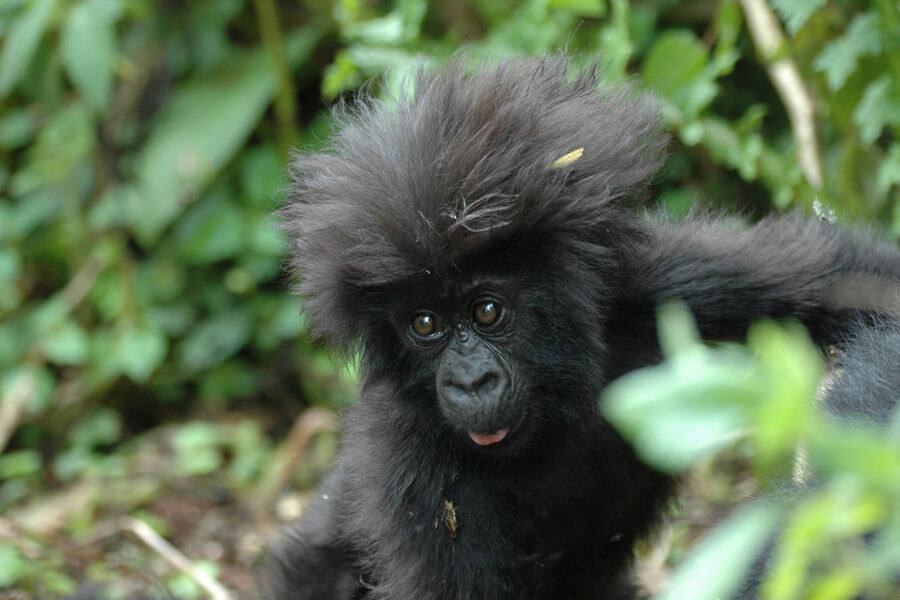
What Do Gorillas Eat In The Wild?
Gorillas are omnivores but their diet is majorly vegetarian. In the Jungle, more than 85% of a gorilla's diet comprises leaves, shoots, stems and vines and the rest is made up of roots, flowers and fruits.
Insects, ants and termites make up less than 1% of a gorilla's diet in the wild.
The specific food of gorillas varies depending on the presence (or absence) of certain plants in the immediate surroundings. Changing seasons also influence food consumption at a given time.
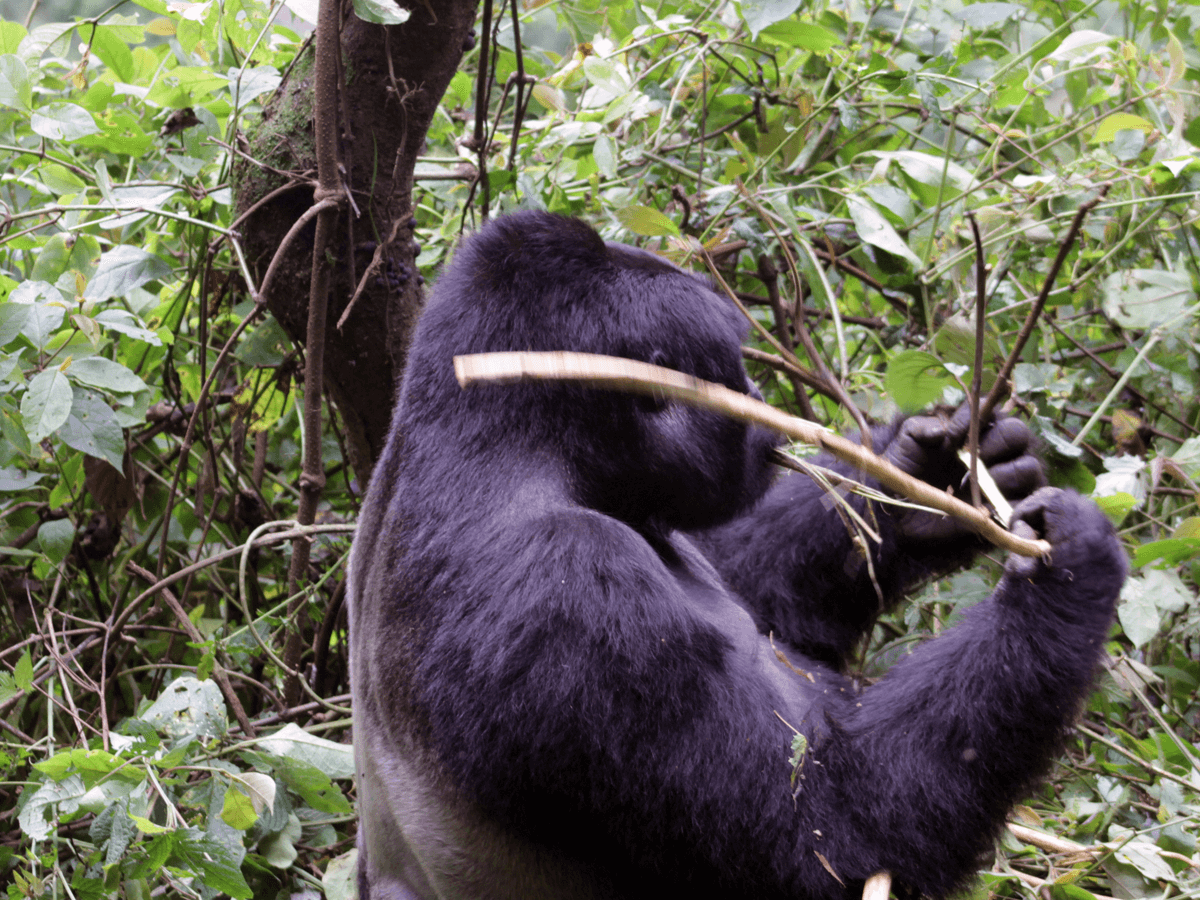
Mountain gorillas eat the least amount of fruits and termites because their high altitude isn't very conducive for fruits or many termites. Western lowland gorillas on the other hand have more fruit in their territory and are keen on termites that they often break termite nests and eat the termite larvae.
Because of the high altitude and low temperatures fruits will take longer to ripen and thus mountain gorillas end up eating fewer fruits. Mountain gorillas do however love fruits, and when it is a fruiting season, their diet will comprise around 90% fruits.
Lowland gorillas enjoy more fruits because the fruits become ripe quickly in the slightly warmer temperatures of their lowland forest habitat.
According to our friend and conservationist Julius Mutale, who was directly involved with gorilla research in Bwindi Impenetrable National Park, Uganda for more than 8 years, the mountain gorillas in Bwindi eat more fruits than those in the Virungas. Similarly, the gorillas in the Buhoma sector of Bwindi eat more fruits than those in Ruhija which is at a slightly more elevated altitude.
Julius worked as part of the Max Planck Institute's long-term gorilla research team in Ruhija and he spends a lot of mornings in the forest with the mountain gorillas. You can follow his Instagram (@biodiversity_bwindi) for fresh pictures of gorillas and Bwindi.
Gorilla Diet Composition Summary
Here is a summary of the dietary composition for each of the 4 gorilla subspecies in the wild.
1. Western Lowland Gorilla (Gorilla Gorilla Gorilla):
- Diet: Consists of 67% fruit, 17% leaves, seeds, and stems, and 3% termites and caterpillars.
- Plant species consumed: At least 97.
2. Eastern Lowland Gorilla (Gorilla Beringei Graueri):
- Plant species consumed: At least 104.
3. Mountain Gorilla (Gorilla Beringei Beringei):
- Diet: Primarily comprises 86% leaves, shoots, and stems, 7% roots, 3% flowers, 2% fruit, and 2% ants, snails, and grubs.
- Plant species consumed: At least 142 (limited fruit availability due to high altitude).
4. Cross River Gorilla (Gorilla Gorilla Diehli):
- Diet: Includes fruit, leaves, stems, piths, and some invertebrates (based on faecal analysis).
- Plant species consumed: Not specified, but includes a variety of vegetation.
Which Plants Eaten By Gorillas?
The diet of gorillas consists of more than 140 plant species that occur naturally in the jungle habitat. Some of these are slightly more common than others.
Here are some 18 plants that are consumed by mountain gorillas in their natural habitat.
|
|
|
|
|
|
|
|
|
|
|
|
|
|
|
|
|
|
How Much Do Gorillas Eat?
Gorillas are big animals and an adult gorilla can eat as much as 27 kilograms (60 pounds) of vegetation in a single day. Generally, the bigger the gorilla, the more it eats to meet the energy needs of a big body.
In a family of gorillas, the biggest gorilla is usually the dominant silverback, and he eats the most in the group.
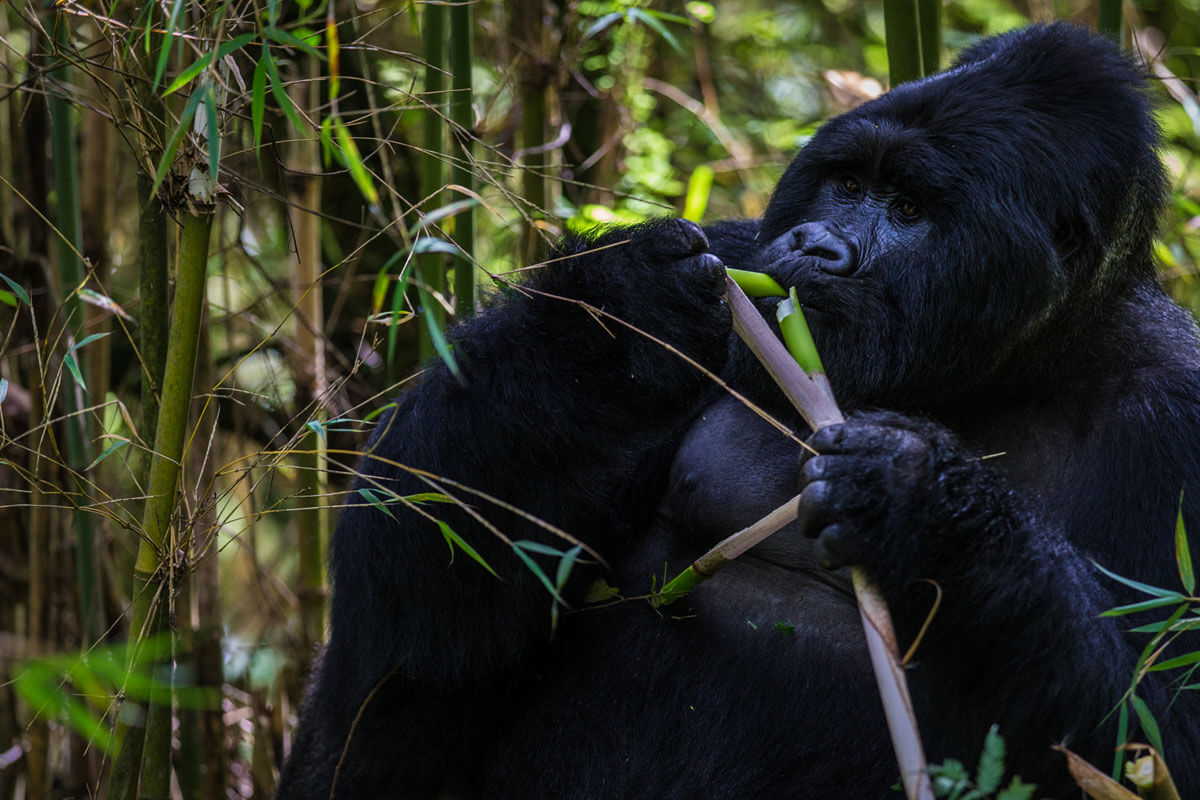
On average, adult male gorillas eat between 18 and 27 kilograms (40 to 60 pounds) of plant material every day. Female gorillas, on the other hand, consume less, at an average of 14 to 23 kilograms (30 to 50 pounds) of food per day.
From those numbers, you can see that a gorilla eats about 10% of its body weight every day. While that is so much food, the nutritional value is limited in the plants they eat, requiring them to consume large amounts.
For comparison and context, an adult human consumes about 1.4 to 2.3 kilograms of food, which is just 10% of what an adult female gorilla needs for a day. Of course, the nutritional qualities are different so we shouldn't simply look at the numbers.
Gorillas' Eating Habits
Gorillas have great eating habits because they practice selective feeding/foraging. As gorillas are eating, they don't overfeed and exhaust one patch of the forest. They feed in a balanced manner that allows the plants to quickly grow and recover.
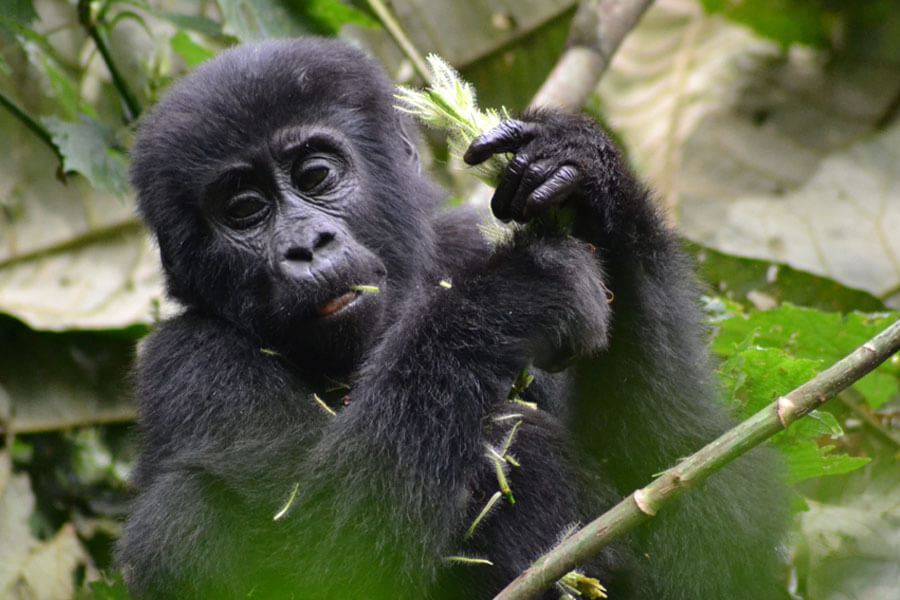
For those plants whose leaves, shoots, and stems are eaten by gorillas, a gorilla will only eat one of the parts and move to the other plant of the same species for a different part. This is how gorillas do it, and this is how they smartly conserve their food sources.
The dominant silverback - as leader of the group, is responsible for the movement in search of food and leads the gorillas under his family. Younger gorillas learn this feeding method by observing the older members of the family.
Related article: Gorilla Habitat. Where mountain gorillas live?
Do Gorillas Drink Water?
Like all animals, gorillas need water in their systems. While gorillas do drink water, they get most of their hydration from the fresh plant material they consume for food.
When they are near a river or stream, gorillas tend to take a sip of water, but they never seek it out as you might witness with other wild animals. Their diet of fresh leaves, shoots and fruits makes up for a lot of the gorilla's water needs.
This is why when you go to see gorillas in the jungle, you will most likely not find them drinking water for the few hours you will spend with them - unless you find them near a stream.
Do Gorillas Eat Meat And Fish?
While science entirely agrees that gorillas are omnivores because they occasionally eat insects such as termites, gorillas do not eat meat or fish. Their strong bite force is for chomping down on some veggies - and a bit of fighting to protect themselves.
According to some research, the DNA of duikers and some monkeys was found in some gorillas' faeces. While the faeces could have been contaminated, the possibility of meat consumption was not fully dismissed since the digestive system of a gorilla is capable of digesting meat.
However, there isn't enough data to support any of these theories and the research continues. You can visit this journal article and follow the research.
Do Gorillas Eat Bananas In The Wild?
You might have seen gorillas and other primates eating bananas at the zoo or in movies, but gorillas in the jungle do not eat bananas, even though they can. It is a matter of access.
While gorillas CAN eat bananas, they typically do not eat them because they have no way of getting to them.
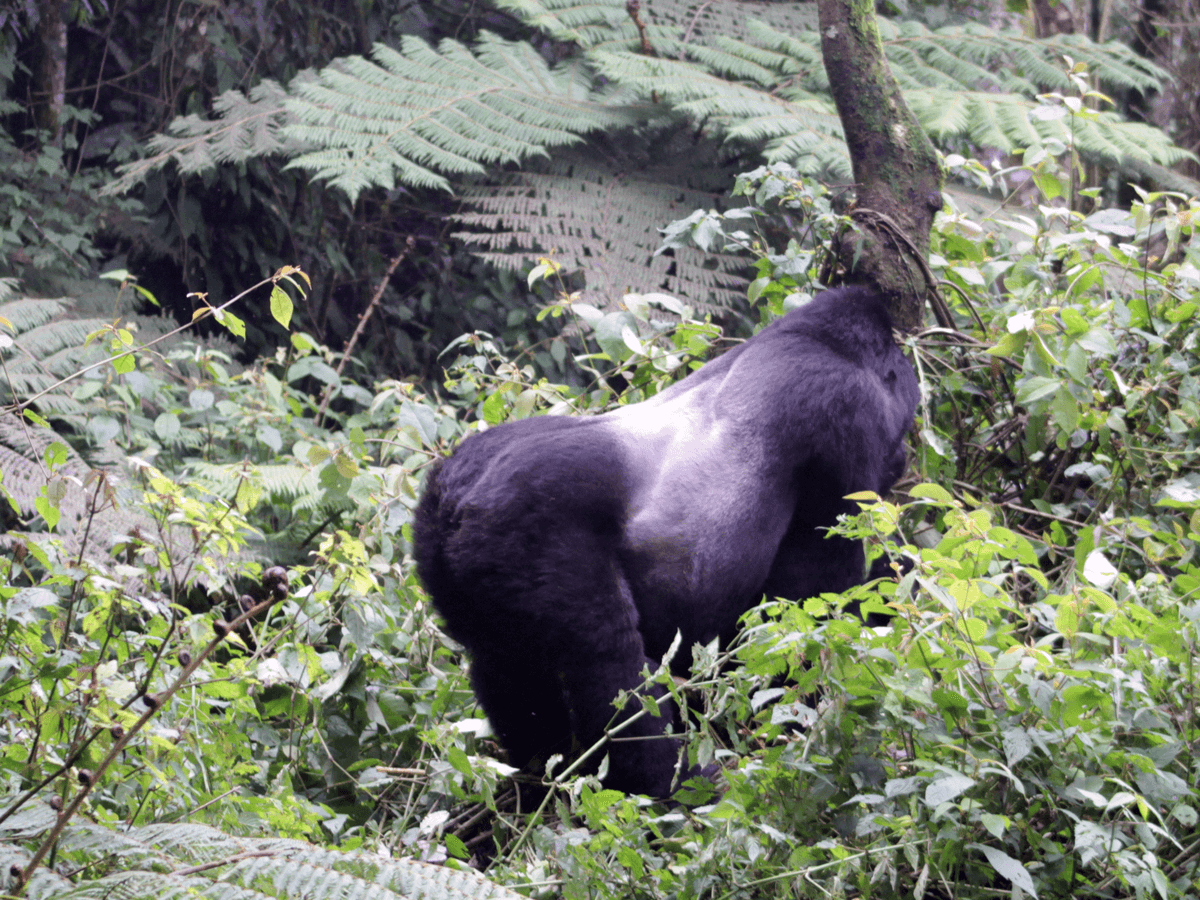
The jungle where gorillas live is very thick with trees that would not allow the bananas to grow. Therefore most gorillas in the wild live their whole lives without ever having eaten or even seen a banana.
In situations when they step out of their protected forests into neighbouring communities, gorillas can be destructive to banana plantations since they can eat everything from the ripe bananas, as you expect but also the leaves and stems of banana plants. When this happens, it brings up conservation challenges and stirs up what is referred to as Human-Wildlife Conflict.
Furthermore, it is illegal to take food, in this case, bananas to animals in the national park and this is why many gorillas in the wild have certainly never tasted a banana.
What Do Gorillas Eat In The Zoo?
In captivity, gorillas are fed a balanced diet of leaves, stems, shoots, fruits, ants, termites, and high-fibre primate biscuits. The leafy vegetable takes up at least 60% of the entire meal while the other ingredients share the remaining percentage.
In the zoo, the health and diet of the gorillas are closely monitored and adjusted depending on the health condition of the gorilla.
In as much as other gorilla species have managed to survive in the captive environment of the zoo, you should know that such attempts failed with mountain gorillas - and as such, all the mountain gorillas in the world still live in their natural habitat - deep in the wild jungle.
Final Thoughts
We hope your questions about a gorilla's diet are fully answered by now. We have to mention that while learning about gorillas is so much fun (and you should keep doing it), seeing them live deep in the forest is beyond description.
If you can get a chance to see gorillas in the wild, you should do it because looking into those red calming eyes or the playful baby gorillas as unsettled as you can imagine a human child, is a humbling and comforting way to connect with nature. Unexpectedly, you will feel at home, sitting among the gorillas.
In case you are interested in taking a trip to see the gorillas, feel free to reach out and we'll help you plan a very successful and gratifying safari to see the gorillas in their natural home.
